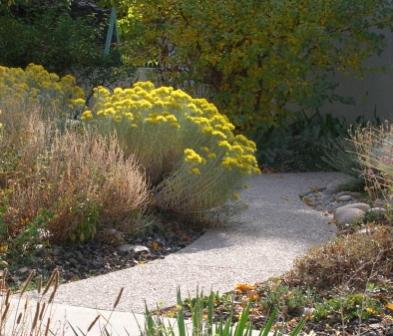Rabbitbrush in the Landscape

Diane Jones, Draggin' Wing Farm, Water-thrifty Plants for Idaho
Scientfic Name: Ericameria nauseosa ssp. nauseosaCommon Name: Gray Rabbitbrush; Rubber Rabbitbrush
Description: Tough native shrub covered with brilliant display of golden flowers in fall. Its upright form and graceful silver foliage make it an ideal foundation plant in the xeric garden. Supports butterflies & birds.
Native Habitat: Widely distributed throughout the arid intermountain West, from desert washes to mountain meadows. Very cold hardy.
Cultural Requirement
Soil: Well-drained, shallow, nutrient-poor or ordinary garden soil.
Moisture Tolerance: Extremely drought-tolerant.
Sun/Shade/Preference: Full sun.
Transplanting: Container-grown rabbitbrush transplants well. Do not try to dig wild plants.
Propagation: Seed.
Maintenance (pruning, fertilization, deadheading, division, irrigation, etc): Cut back to 6-12" in the early spring. This keeps plants attractive and compact. Needs little or no fertilization.
Insect, disease, or other problems: None of concern.
Landscape Value
Use in the Landscape: Attractive and reliable foundation plant for very arid areas.
Foliage: Narrow, silvery leaves on woody branches.
Flower: Vibrant display of yellow flowers in fall.
Timing: September-October
Color: Yellow
Fruit: The fruit is an achene 0.03 to 0.05 inch long.
Form: Upright woody shrub.
Texture: Loose, branching.
Ultimate Size: 3' 5' tall and equally wide.
Rate of Growth: Moderate.
Suggested Plant Partners: Native grasses, any Buckwheat Pussytoes.
Availability: Available at native plant nurseries.
Cultivars: None.
References:
Earle, A. Scott & James L. Reveal, Lewis and Clark's Green World, The Expedition and its Plants, Farcountry, 2003, p. 39.
Love, SL. 2009. Landscaping with Native Plants, University of Idaho Bulletin No. 862, p.14.
Meyer, Susan et. al., Landscaping on the New Frontier, Waterwise Design for the Intermountain West, Utah State University Press, Logan, 2009, p. 199.
Mee, Wendy et. al. Waterwise, Native Plants for Intermountain Landscapes, Utah State University Press, Logan 2003, p. 22.

